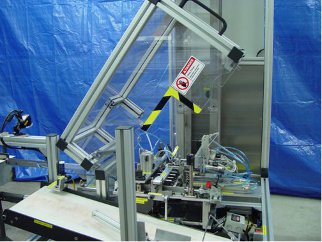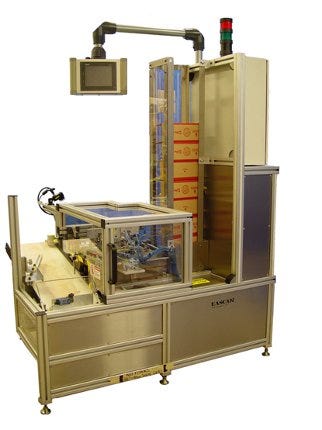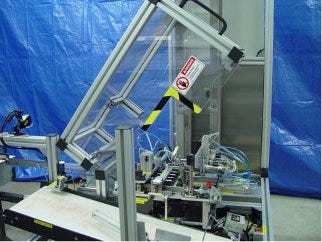Vision system improves productivity at the Royal Canadian Mint by 60%
March 11, 2015

With a worldwide reputation for product quality, customerservice, and minting technology, the Royal Canadian Mint (RCM) is at theforefront of innovation in producing coinage and currency. The Mint usesadvanced automation equipment to count and wrap pennies in rolls. However, inthe past these rolls were manually inspected for the number of penniescontained and the integrity of each package. Recently, the Mint has improvedefficiency by implementing a machine vision system that checks the package tomake sure it is intact and verifies that the roll is the correct length. Themachine vision system has improved inspection productivity from 25,000 to40,000 rolls per shift and reduced downtime while eliminating a difficult and troublesomemanual task.

Eascan inspection and packaging machine
A commercial Crown corporation of the Government of Canada,the RCM has over 800 employees with facilities in Ottawaand Winnipeg. TheRCM's business lines include Canadian and foreign circulation coins, numismaticcoins (for collectors), gold, and other bullion investment products andrefining. The RCM produces all of Canada's circulation coins and is a leadingproducer of coins for foreign countries with approximately a one-third share ofthe world market. From 1976 to 2010, the RCM has manufactured coins for 75 countries.These coins are produced at the Royal Canadian Mint's facility in Winnipeg.
Penny manufacturing process
The metal disks called blanks that become pennies are firstrun through a rimmer that forms the circumference of the blank to achieve araised edge. The blanks are then mechanically fed into a coining press. Twocoin dies come together to strike the image on both sides of the coin at once.The coin is then ejected from the press, is fed through an optical inspectionprocess and then into a packaging machine. The machine accumulates 50 penniesand then inserts a metal ball between every 50th penny and the startof the new roll. The machine then extrudes a continuous plastictube around the pennies and steel balls, cuts the tube at each ball, and separatesthe finished rolls from the balls (which are re-used for more rolls).
There are a number of potential problems that can occur inthe automated boxing process. For instance, the ball might not be rejected, inwhich case it might be wrapped into a roll of pennies or might also remainloose on the conveyor. Also, if a ball is missing, then a roll might be createdwith too many pennies. On the other hand, rolls are sometimes created withfewer than the specified number of pennies. In the past, an operator wasresponsible for watching the rolls as they came by and pushing a button toreject any non-conforming rolls. The use of manual inspection created the potentialfor error. Every time a long roll, short roll, or ball bearing slipped throughit would jam the automated boxing machine down-line that put the rolls intoboxes. It took about five minutes to clear the wrapping machine.
Machine visionbecoming viable for inspection
Inspection applications such as this one have traditionallybeen manually inspected because of the challenges they present for automatedinspection. But in recent years, vision systems have become more powerful andless expensive, so the Mint decided to take another look at automatinginspection of the pennies. The Mint discussed potential automation solutionswith Eascan Automation Inc., a custom machine builder that provides mechanicaldesign, fabrication, assembly, testing, service, and support of automatedmachine solutions.

Closeup of inspection station with Checker vision sensor at far left
"We looked at the application and quickly determined thatthe boxing portion of the application could not be accommodated by conventionalsolutions, and that the inspection operations would require a particularlycreative solution," said Phil Bernadin, Owner of Eascan. "Machine vision haslong been much more intelligent than other types of sensor technologies, butuntil recently, it was expensive, bulky, and difficult to configure. But theseissues have been all but eliminated in recent years with the introduction of anew generation of vision technology. The cost of vision technology has droppedto the point that you can purchase a very capable system for under $1,000. Thelatest vision sensors are self-contained and quite compact. Most important,point-and-click interfaces combined with high-level vision tools make itpossible for even first-time users to configure and maintain vision applicationsin a matter of minutes."
"We selected the Cognex Checker 3G1 vision sensor for thisapplication because of its low cost, small size, and wide range ofcapabilities," Bernadin added. Checker vision sensors integrate lighting,optics, camera, processor, and I/O in an industrial IP67 housing small enoughto fit into the tightest of spaces. Checker technology detects and inspectsparts by understanding what they look like. This approach overcomes varyingpart positioning which eliminates the need for costly fixturing. An intuitiveGUI makes it possible for even a first-time user to setup an application inminutes.
Developing theinspection application
Bernadin assisted in the design of the inspection and automatedboxing machine that accepts wrapped rolls from the upstream wrapping machine. Hethen set up the vision sensor to interface with the Allen-Bradley MicroLogix1500 programmable logic controller (PLC) that operates the packaging machine.He connected the vision sensor to the PLC with a 12-conductor cable. The inspectionoperation begins when a proximity sensor detects an object moving down theconveyor and triggers an image acquisition. The camera then sends a Part Pass"and a "Part Detected" to the PLC. ThePLC is programmed so that if a roll is not found within 100 milliseconds of anobject being detected, then the object is rejected by an air stream. In nearlyevery case, the rejected objects are the steel balls used in the packagingprocess of the rolls.
Bernardin began programming by connecting the vision sensorto a PC, installing the programming interface on the PC and positioning thevision sensor to capture an image of a roll of pennies. Light reflects off thecrest of the pennies through the transparent wrap and creates a brightrectangle. The steel balls, if they are present, generate a point source oflight. Bernardin created a search region around the roll and selected a brightnesstool. He used the pattern tool to ensure that the sensor detected the rollevery time. When a roll is found, the vision sensor activates a static outputthat is connected to the PLC.
When the pattern tool finds a roll, two contrast tools areapplied at either end of the bright region to locate the ends of the roll. Thedifference between the x coordinates of these two contrast tools is thencalculated to determine the length of the roll. This number is in turn dividedby the thickness of a penny to determine the number of pennies in a roll. Bernadinsaid the contrast tools on the 3G1 are capable of determining the number ofpennies in the roll to +/-2. However, in this application, it's only importantto know the approximate number of pennies so he opened up the tolerance of thecontrast tool to be certain to detect rolls with gaps between pennies which arerejected. If the number of pennies is below or above the allowable limits, thenthe vision sensor activates another static output connected to the PLC toindicate that the roll has failed inspection. In that case, the PLC rejects thepart.
Bernardin tested the program and determined that it providesvery high accuracy in detecting non-conforming and good rolls, as well asforeign metal objects such as the balls. He then set up the Cognex Checker programming interface, which provides access to the same graphical programminginterface that used to program the application. He trained the machineoperators to maintain the program. The operators now can make changes to theprogram on their own. For example, if the camera moves they can easily changethe inspection regions. The machine built by Eascan then stacks 50 rolls into acassette and puts the rolls in a box.
"This inspection system offers advantages to the automated boxingmachine," Bernardin concluded. "It has nearly eliminated downtime caused in thepast when non-conforming rolls or ball bearings jammed up the machine. Itinspects rolls at a rate of 40,000 per shift, much faster than a humaninspector, making it possible to increase the speed of the automated machinery.The vision system is robust and can be easily maintained by shop personnel. Inthe end, it is a much better way to inspect rolls of pennies."
SOURCE: Cognex
.
About the Author(s)
You May Also Like


